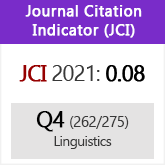Geminate blockage in Logoori harmony with no added machinery
DOI:
https://doi.org/10.3989/loquens.2019.064Keywords:
Harmony, formalism, rule, geminates, adjacencyAbstract
Following the demise of the SPE theory of phonology, little attention was paid to how rules should be formulated. Instead, there was a general trend to minimize the language-specific component of a grammar, to factor out recurring patterns and state them as independent constraints or parameters. The richer representations of autosegmental phonology additionally led to uncertainty in rule formulation, primarily because of questions about what the correct representations are, but also because specifying dominance and precedence relations is more complex than just specifying precedence relations. This paper discusses a vowel harmony rule in the Bantu language Logoori, which is blocked by an intervening geminate consonant. It is typologically surprising that an intervening geminate has an effect on harmony, and there is no clear model for how such an effect in a rule should be encoded. It is shown that the effect follows naturally from correctly formalizing the rule, with attention to how rule and representational substrings are matched, and no rule-external conditions on the rule are necessary.
Downloads
References
Baković, E. (2005). Antigemination, assimilation and the determination of identity. Phonology, 22, 279-315. https://doi.org/10.1017/S0952675705000631
Butler, L. (2005). Exceptional blocking of Yucatec Maya vowel harmony. LSO Working Papers in Linguistics, 5: Proceedings of the Workshop in General Linguistics 2005 (pp. 25-39). University of Wisconsin, Madison: Linguistics Students Organization.
Chomsky, N. & Halle, M. (1968). The Sound Pattern of English. New York: Harper and Row.
Clements, G. N. & Hume, E. (1995). The internal organization of speech sounds. In J. Goldsmith (Ed.), Handbook of Phonological Theory (pp. 245-306). Oxford: Basil Blackwell.
Clements, G. N. & Keyser, S. J. (1983). CV Phonology: A Generative Theory of the Syllable. Cambridge, MA: MIT Press.
Davis, S. (1994). Geminate consonants in moraic phonology. West Coast Conference on Formal Linguistics, 13, 32-45.
Davis, S. (2011). Geminates. In M. van Oostendorp, C. J. Ewen, E. Hume & K. Rice (Eds.), The Blackwell Companion to Phonology (pp. 873-897). Malden, MA & Oxford: Wiley-Blackwell. https://doi.org/10.1002/9781444335262.wbctp0037
Hayes, B. (1989). Compensatory lengthening in moraic phonology. Linguistic Inquiry, 20, 253-306.
Howard, I. (1972). A Directional Theory of Rule Application in Phonology. Doctoral Dissertation, MIT: Cambridge.
Kenstowicz, M. & Pyle, C. (1973). On the phonological integrity of geminate clusters. In M. Kenstowicz & C. Kisseberth (Eds.), Issues in Phonological Theory (pp. 27-43). Mouton: The Hague. https://doi.org/10.1515/9783110905137.27
Krämer, M. (n.d.). A correspondence approach to vowel harmony and disharmony. Rutgers Optimality Archives (ROA) 293. http://roa.rutgers.edu/files/293-0199/roa-293- kraemer-4.pdf
Krämer, M. (2001). Yucatec Maya vowel alternations - Harmony as syntagmatic identity. Zeitschrift für Sprachwissenschaft, 20, 175-217. https://doi.org/10.1515/zfsw.2001.20.2.175
Leben, W. (1980). A metrical analysis of length. Linguistic Inquiry, 11, 497-509.
McCarthy, J. (1979). Formal Problems in Semitic Phonology and Morphology. Doctoral Dissertation, MIT. h
McCarthy, J. (1986). OCP Effects: Gemination and antigemination. Linguistic Inquiry, 17, 207-263.
McCarthy, J. (1988). Feature geometry and dependency: A review. Phonetica, 45, 84-108. https://doi.org/10.1159/000261820
McCawley, J. (1974). Review of The Sound Pattern of English by Noam A. Chomsky and Morris Halle. International Journal of American Linguistics, 40, 50-88. https://doi.org/10.1086/465290
Morén, B. (1999). Distinctiveness, Coercion and Sonority: A Unified Theory of Weight. Doctoral Dissertation, University of Maryland at College Park.
Odden, D. (1988). Anti Antigemination and the OCP. Linguistic Inquiry, 19, 451-475.
Odden, D. (1994). Adjacency parameters in phonology. Language, 70, 289-330. https://doi.org/10.2307/415830
Odden, D. (2011a). The representation of vowel length. In M. van Oostendorp, C. J. Ewen, E. Hume & K. Rice (Eds.), The Blackwell Companion to Phonology (pp. 465-490). Malden, MA & Oxford: Wiley-Blackwell. https://doi.org/10.1002/9781444335262.wbctp0020
Odden, D. (2011b). Rules v. constraints. In J. Goldsmith et al. (Eds.), Handbook of Phonological Theory, vol 2 (pp. 1-39). Malden, MA & Oxford: Wiley-Blackwell. https://doi.org/10.1002/9781444343069.ch1
Odden, D. (2013). Formal phonology. In S. Blaho, M. Krämer & B. Morén-Duolljá (Eds.), A Festschrift on the Occasion of X Years of CASTL Phonology and Curt Rice's Lth Birthday. Nordlyd, 40.1, 249-273. https://doi.org/10.7557/12.2476
Parkinson, F. (1996). The Representation of Vowel Height in Phonology. Doctoral Dissertation, Ohio State University.
Pulleyblank, D. (2011). Vowel height. In M. van Oostendorp, C. J. Ewen, E. Hume & K. Rice (Eds.), The Blackwell Companion to Phonology (pp. 491-518). Malden, MA & Oxford: Wiley-Blackwell. https://doi.org/10.1002/9781444335262.wbctp0021
Pyle, C. (1971). On the Treatment of Length in Generative Phonology. Doctoral Dissertation, University of Illinois.
Reiss, C. (2003). Quantification in structural descriptions: Attested and unattested patterns. The Linguistic Review, 20, 305-338. https://doi.org/10.1515/tlir.2003.012
Published
How to Cite
Issue
Section
License
Copyright (c) 2020 Consejo Superior de Investigaciones Científicas (CSIC)

This work is licensed under a Creative Commons Attribution 4.0 International License.
© CSIC. Manuscripts published in both the printed and online versions of this Journal are the property of Consejo Superior de Investigaciones Científicas, and quoting this source is a requirement for any partial or full reproduction.All contents of this electronic edition, except where otherwise noted, are distributed under a “Creative Commons Attribution 4.0 International” (CC BY 4.0) License. You may read here the basic information and the legal text of the license. The indication of the CC BY 4.0 License must be expressly stated in this way when necessary.
Self-archiving in repositories, personal webpages or similar, of any version other than the published by the Editor, is not allowed.















